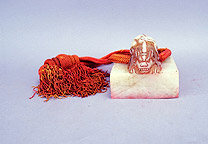
Item: Miscellaneous
| Origin Location | China |
|---|---|
| Date Range | 1200 - 1299 |
| Collection | Private |
| Catalogue # | Tibet Museum, Lhasa |
Classification: Object/Concept
Seal of the Yuan Spiritual Preceptor, Chogyal Pagpa.
In 1253, Kublai Khan appointed Chogyal Pagpa, (1235-1280), Abbot of Sakya, to the Mongol capital at Dadu, to serve as his religious teacher. This seal was made seven years later, when Kublai granted Pagpa the official title guoshi or ?National Preceptor.? The title, and its subsequent embellishments, came with gifts of prestige, territory, luxury items, and importantly, the ear of the Emperor. The Imperial Preceptor was required to attend court, and the resulting flow to and from China of Tibetans formed a strategic channel for cultural exchange.
This seal marks an important stage of Chinese and Tibetan statecraft. By taking a Sakya preceptor, the Yuan monarch empowered one Tibetan religious order over the others, securing the allegiance of the chosen sect, while planting seeds of discontent among the rivals. By accepting this appointment, Chogyal Pagpa, took part in the Imperial administration, and received the honor of religious authority in China. As with other government officials, however, preceptor titles and seals were issued by Imperial order, and could always be withdrawn or changed. Religious authority was held in check by factions at the Chinese court that did not want to tip the balance of Imperial favor toward any single individual, let alone a foreigner.
The crouching mythical beast on the top of the seal is a ?qilin,? believed to appear only when a just and glorious monarch reigns.
Exhibition: Tibet, Treasures from the Roof of the World
Thematic Sets
Sculpture: Miscellaneous
